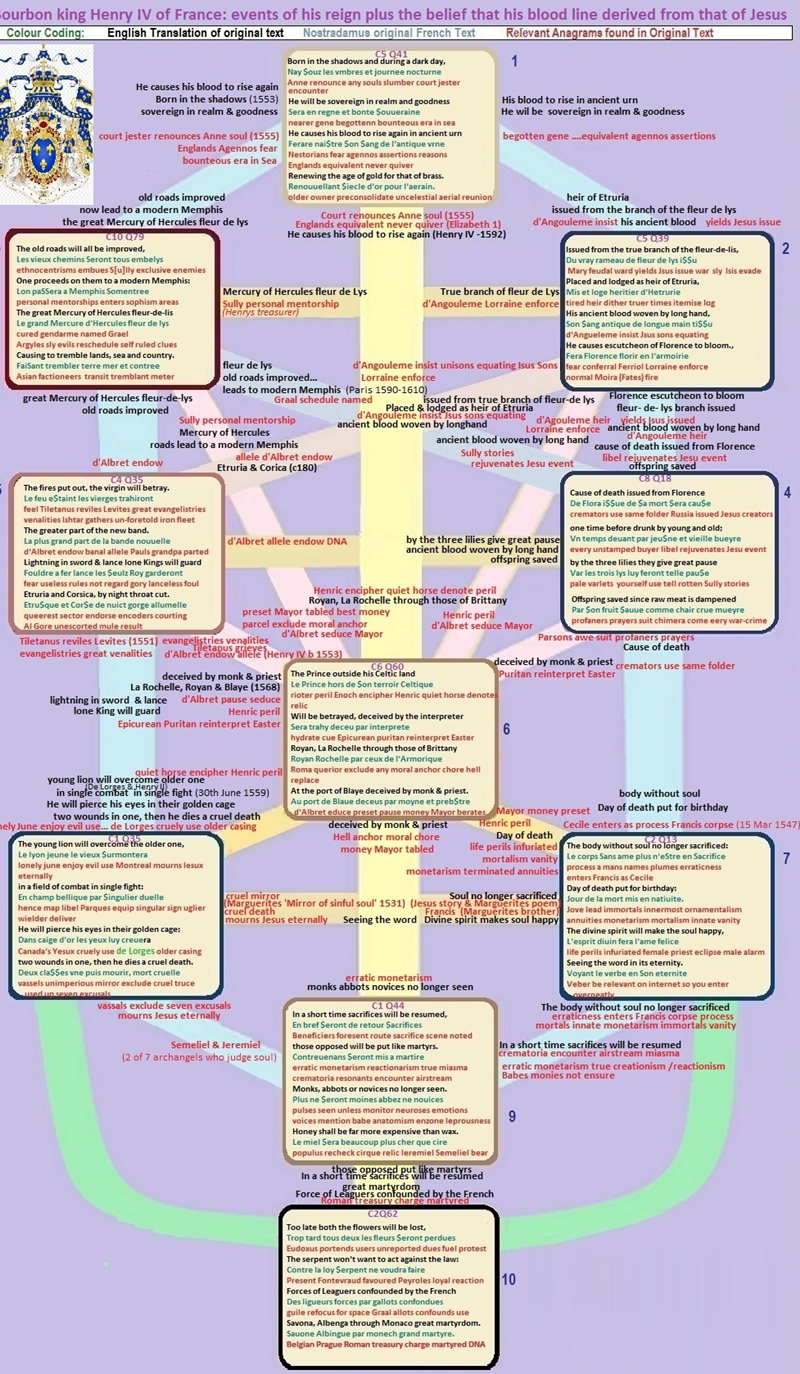 Analyses of all verses
Analyses of all verses
|
 Web Site
Web Site |
 All
Sefirots All
Sefirots |
NOSTRADAMUS, Anne Boleyn & Midsummers Nights Dream© Allan Webber 2011, 2013.Home Site: nostradamuscodes.com C1 Q45 A founder of sects, much trouble for the informer:
(Secteur de Sectes grand peine au delateur) |
| ||||||
|
In my paper Nostradamus on sects there is a section that shows the above verse is clearly about the topics of this paper. In it I also state that its basic story is a most unusual sub ject, Shakespeare's Midsummer's Nights Dream at the Theatre, Curtain Lane, Shore-ditch London. In presenting that verse I showed that there was reason to believe that verse C1 Q45 alludes to Anne Boleyn and her daughter Elizabeth. This paper is an expansion on my earlier work showing why I believe it is a key verse in Nostradamus tale of religious mutation. In it I will show reasons for Nostradamus' interest in Shakespeare and highlight that he chose the original presentation of this particular play of Shakespeare because it locates a specific religious thread in order to give a precise location and date. |
Persons of Interest
|
Nostradamus' interest in Anne Boleyn
At the time of first discovery it perplexed me as to why this verse was in Nostradamus. The clarity of its contents suggested it was meant to be a powerful hub providing ciphers of major relevance. As time has gone on I have found what I believe are the reasons behind Nostradamus including this reference point in history.
It has taken some time but in January 2012 I became aware of the close proximity of Nostradamus to Marguerite of Navarre when he lived in Agen. At this time in the 1530's Nostradamus would have become very interested in the tumultuous actions taking place across the Channel as Henry VIII broke away from allegiance to the Pope in order to divorce his then wife, Catherine of Aragon and marry Anne Boleyn.
Nostradamus was still in Agen when, on spurious charges, Henry had Anne executed. These events held greater poignancy than just a voyeuristic interest in a royal neighbour since Anne Boleyn had strong connections to Marguerite of Navarre whose court at Nerac was only a few kilometres from Agen. And it is here that Anne Boleyn was exposed to activists wanting religious reform and was shaped by the intellectual strengths of Marguerite.
The following extracts are to be found in Wikipedia's entry on Marguerite of Navarre.
Anne Boleyn had been a lady-in-waiting to Queen Claude during her seven years in France (1515 - 1522) before returning to England. There is conjecture that the court of Queen Claude and the court of Marguerite overlapped and that, perhaps, Anne was in service to Marguerite rather than to Claude, as well as that Anne Boleyn may have become a friend, admirer, and disciple to Marguerite, who absorbed Marguerite's radical views about Christianity. A written letter by Anne Boleyn after she became queen exists in which the Boleyn makes strong expressions of affection to Marguerite.
It is further suggested that Marguerite gave Anne the original manuscript of Miroir de l'âme pécheresse (Mirror of the sinful soul) at some point. It is certain that in 1545, nine years after Anne Boleyn's execution by her husband Henry VIII, that Anne's daughter Elizabeth (1533–1603), who would become Elizabeth I (1558-1603), translated this very same poem by Marguerite into English when she was twelve years old and presented it, written in her own hand, to her then-stepmother, the English Queen Katherine Parr. This literary connection among Marguerite, Anne, Katherine Parr, and the future Queen Elizabeth I suggests a direct mentoring link between the legacy of reformist religious convictions and Marguerite.
The Theatre, Shoreditch London (1576 to 1597)
The Theatre was built in 1576 by James Burbage, father of the actor Richard Burbage. It was the first permanent theatre in London and was located at Curtain Rd in Shoreditch, north-east of the City but just outside its jurisdiction. It was an open-air amphitheatre, with three tiers of galleries and a covered stage. From 1594, the Theatre became the playhouse of the Lord Chamberlain’s Men, a group that included William Shakespeare. After the lease on the site expired in 1597, the Burbages dismantled the Theatre and in 1599 rebuilt it as the Globe on the other side of the Thames. Shakespeare held a 10% shareholding in this new theatre. One of the last performances in the Theatre was the opening night of Midsummer's Nights Dream.
As I have shown in Nostradamus on sects verse C1 Q45 is clearly about this play. But if it is about the Theatre in 1597 when the play Midsummer's Night Dream was played for the last time at that theatre then there is the recurring problem with Nostradamus work, he could only have written this verse with knowledge of the future. And if he did have that ability the same question arises as to Anne Boleyn, why was the Theatre of interest to Nostradamus. I believe the answer begins with Marguerite and in order to show why I will re-analyse the verse C1 Q45 showing some of its other detail.
| A
founder/sector of sects, much trouble for the informer: A beast in the theatre prepares the scene and plot The author ennobled by acts of older times; the world is confused by schismatic sects. |
Secteur de Sectes grand peine au delateur Bette en theatre dreSSe le jeu Scenique Du faict antique ennobly l'inuenteur Par Sectes monde confus et SchiSmatique. |
Many translations of this verse show the beginning of the first line as a founder of sects whereas it more aptly says a sector (or district) of sects. A founder of sects is highly unlikely unless the person alluded to changes religion. However many cities have districts where different religions or ethnicities are compelled or choose to live.
It is noteworthy that one of the claims for the reign of Anne Boleyn is that she achieved the greatest changes of any royal in English history by causing the break with Rome and the sub sequent rise of Protestantism in England. As such Anne Boleyn was a founder of sects and Thomas Cromwell who brought about her downfall did encounter much trouble as he was beheaded four years after Anne Boleyn.
If he foresaw these future events in England then Nostradamus would probably be content that such a connection should be made because his aim seems always to be to produce allusions that point to the real significance of a verse rather than to produce a detailed record. And by the usage of the word sector we are led to a similar end but one that is more in keeping with the time suggested by the rest of the verse.
It is in the later half of the century that the religious wars in France and elsewhere become significant to England as this is the beginning of the Huguenots flight from persecution. Many came to London and they sought shelter in the East End and particularly Shoreditch where the Theatre was located.
The purpose of the inclusion of something as precise as Midsummer's Nights Dream would therefore seem to be the definition of a date and place of relevance to Nostradamus major themes. Here we have a date of 1596 at Shoreditch where French Huguenots loyal to Jeanne d'Albret and her son, King Henri IV of France were living.
It also establishes the idea of a connection to the English Royal family derived from the line of Anne Boleyn who in turn had a relationshito the grandmother of King Henri IV, Marguerite of Navarre. And Queen Elizabeth I of England was one of the supporters of the Huguenots during the Religious Wars of France on the Protestant side especially in 1585 and 1590 to 1594 when Henri IV became rightful King of France.
Throughout every element of this trail we see the emergence of new religious ideas, new sects and the mutation of religion predicted by Nostradamus as one of his three major mutations. C1 Q45 therefore becomes a verse from which we can expect much more to emerge as various links within the Prophecies are enhanced and better understood.
In September 1585, Henry of Navarre was excommunicated by the pope Sixtus V. This gave Henry of Navarre a very real reason to fight - he was now the legitimate target for any Catholic who was free to murder him without committing a sin.
Navarre had two armies. One of these was paid for by the English. In 1587, Navarre defeated Henry III at the Battle of Coutras but his army of mercenaries - paid for by the English - was beaten in the same year by an army of the Guise’s.
Henri III of France dies in 1589 and Henry III of Navarre, named as the rightful heir, becomes Henry IV, King of France.
Henri of Navarre was now king. His sole aim initially was to defeat the Catholic League. His plan was to buy off support for the League and open combat. He had one major advantage over all his opponents - he was the legal and legitimate heir to the French throne. Those in the League were clearly not.
Many problems remained but his perceived ability to better control the mobs in the cities was a dominating issue, outweighing his Protestantism. And his opponents in the League were tainted with Spain as it had accepted Spanish money and troops whereas Henry IV was not tainted in this manner and thus appealed to French patriotism. The fact that he received English helfrom 1590 to 1594 did not seem to worry the French as much as the Spanish help that the League had received.
This section augments that presented in Nostradamus on sects.
Once again C1 Q45 has more to contribute:
| A
founder/sector of sects, much trouble for the informer: A beast in the theatre prepares the scene and plot The author ennobled by acts of older times; the world is confused by schismatic sects. |
Secteur de Sectes grand peine au delateur Bette en theatre dreSSe le jeu Scenique Du faict antique ennobly l'inuenteur Par Sectes monde confus et SchiSmatique. |
Midsummer's Nights Dream contains a play within a play and in the second scene, first act there is a character called Quince who presents the scene and plot of the play that he will create from an ancient tale. It is worth noting here that there is an anagram of Quince at the end of Nostradamus' second line ( Bette en theatre dreSSe le jeu S cenique). There are eight other places in the Prophecies where this anagram can be found.
'Bette in the theatre' is a particularly strong multi-layered allusion with one of its meanings being Queen Elizabeth I (Bette) at The Theatre, the name for the building where Midsummer's Nights Dream was first played.
And an anagram for Queen Bolyn, Elizabeth's mother, appears in the third line of this verse and nowhere else. There are other anagrams in the third line that apply to the play e.g. urDufa for dwarf and ai(c)tanti queen for Queen Titania. And these allusions may imply the names of the participants who were conspirators.
In the play there is the following exchange.
BOTTOM
First, good Peter Quince, say what the play treats on, then read the names of the actors, and so grow to a point.
QUINCE
Marry, our play is, The most lamentable comedy, and most cruel death of Pyramus and Thisby.
As Nostradamus' verse correctly implies in its second line there is a beast in the theatre in the form of a lion in Shakespeare's play and its presence is raised at the time during the 2nd scene 1st act where the plot of Quince's play is laid out. This is in addition to Bottom's transformation to a person with a mule's head.
The third line is also given relevance by the choice of Pyramus and Thisby, the basis of an ancient tale of tragedy from love denied. But it may also imply that Queen Elizabeth held a meeting in The Theatre which set the plans for a secret set of actions.
It is quite extraordinary that even if Nostradamus could see the future that he had detailed knowledge of English literature but here it does seem to be the case. And this verse is not the only one where strong evidence can be found that Nostradamus had insight into notable literary and artistic works on which he draws for ciphers to clarify future events.
C1 Q20 and C10 Q46 are cases in point as they appear to draw on Wagner's works in the cities of Brunswick and Nuremberg in the 19th Century. They contain Meistersinger and Music.and.Drama as their anagrammatic ciphers but these aren't the focal point of this paper.
Some relevant contextual references to Anne Boleyn, Elizabeth I and Henry IV of France
The following extract is from Wikipedia's article on Anne Boleyn (Click here for full article)
Anne Boleyn (1501/1507[4] – 19 May 1536) was Queen of England from 1533 to 1536 as the second wife of Henry VIII of England and Marquess of Pembroke in her own right.[5] Henry's marriage to Anne, and her sub sequent execution, made her a key figure in the political and religious upheaval that was the start of the English Reformation. A commoner, Anne was the daughter of Thomas Boleyn, 1st Earl of Wiltshire and his wife, Lady Elizabeth Howard, and was educated in the Netherlands and France, largely as a maid of honour to Claude of France. She returned to England in early 1522, in order to marry her Irish cousin James Butler, 9th Earl of Ormond; however, the marriage plans ended in failure and she secured a post at court as maid of honour to Henry VIII's queen consort, Catherine of Aragon.
Loves Labours Lost was written contemporaneously with Midsummer's Dream and this play was a tale based on Henri IV of France and his court at Nerac in Southern France. It seems appropriate to present a short section of the work of a student on this play as it gives the reason why she and countless others have been fascinated by Henri IV and Shakespeare's Love's Labour Lost.
Shakespeare's Navarre - Keri Posenauer '04 (Click here for full article)
William Shakespeare incorporated the setting and characters of King Henry of Navarre's court into his play Love's Labour's Lost. The text parallels this historical figure accurately, with Shakespeare adding a few twists and turns along the way. Learning why he chose this individual is apparent by the end of the play. King Henry had all of the qualifications that one would want in a king, and not only that, but his court was full of intrigue. Deception, adultery, loyalty, gossiping, and countless other characteristics dominated his court and made for some very interesting situations. It was because of this atmosphere where anything and everything could happen, along with the prosperous region of France, that Shakespeare decided on the setting and characters of his play.
King Henry of Navarre became King Henry of France in August of 1589. In his fifteen-year reign, he was deemed a protector of the Protestant churches (Baird II: 179), and was considered a courageous, humane, and merciful soldier and king (Baird II: 223). He even set up schools for Protestant children, so they could receive the same education as Catholics (Baird II: 477). He was one of the greatest kings that France would ever have. It was even said that posterity never remembered a more deserving French king who was more cherished by his people (Baird II: 489). It is no wonder, then, why Shakespeare would have mode l led the play's main character after this man.
At this time, King Henry was just the ruler of Navarre, a large region in Southern France. Henry lived adjacent to the French palace until he found himself out of favor with the court. He then escaped to the capital city of his kingdom, Nérac.

END Of PAPER